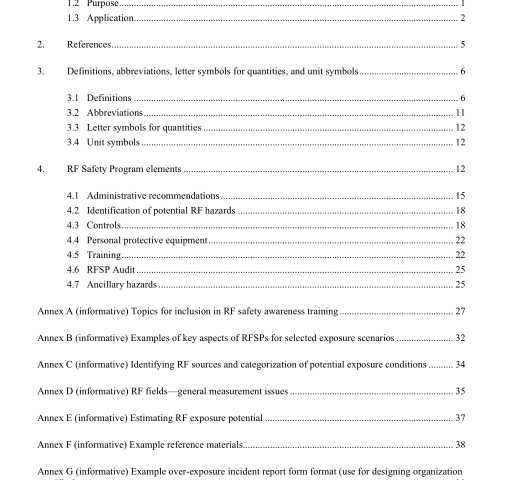IEEE C95.7-2005 pdf download.IEEE Recommended Practice for Radio Frequency Safety Programs, 3 kHz to 300 GHz
These guidelines are provided to assist in the development of RF safety programs for the use of RF energy- producing devices, equipment, and systems, and to control any potentially hazardous exposure of workers or the public. The means for accomplishing this are by first characterizing areas into one of four exposure cate- gories according to the potential risk for exposure above prescribed RF exposure limits, as described in 1.3, then specifying the appropriate controls to reduce the likelihood of over-exposure. For many situations, this guidance will assist in the development of site-specific RF safety programs, while in others the programs may be developed to apply across a wide range of exposure environments. These guidelines are designed to complement the IEEE C95 family of standards on electromagnetic safety, but may find use in the development of effective programs to ensure conformance with other guidelines, standards, or regulations for controlling human exposure to electromagnetic energy. This recommended practice provides guidelines for establishing RF safety programs, but other recommendations may already exist that are deemed sufficient by local regulatory authorities for achieving RF safety in particular environments. Hence, other recommendations could potentially replace or be used in conjunction with the recommendations in this document. Guide lines developed for specific applications, for example, radio amateur operations (see ARRL [B4] 2 ), and electrical transmission/distribution personnel working near mobile phone base-station antennas installed on electric utility structures (see IEEE P1654 [B23]), represent two such examples.
1.3 Application
The objective of this recommended practice is to provide guidance for the implementation of an RF safety program. Such programs are recommended whenever exposures have the potential to exceed a defined action level or exposure limit. Action levels or exposure limits are typically defined in the applicable safety standard. How the levels or limits are defined and controlled is an important part of an RFSP. For purposes of this recommended practice, action levels are any of the following criteria (where applicable):
— The lower tier limits of IEEE Std C95.1.
— The general public (lower tier) of the International Commission on Non-Ionizing Radiation Protec- tion (ICNIRP) guidelines (see ICNIRP [B16]).
— The general population/uncontrolled exposure limits of the U.S. Federal Communications Commis- sion (FCC) (see FCC 47 CFR 1.1310 [B12]).
— 1/5 of the American Conference of Governmental Industrial Hygienists (ACGIH) threshold limit values (TLVs) (see ACGIH [B2]).
The assessment of the action levels includes all applicable aspects of temporal and spatial averaging as specified in the associated standards, guidelines and regulations. It also includes a consideration of the pre- cedence of fundamental limits [such as basic restrictions (BRs)] over derived limits (such as MPE levels, investigation levels, and reference levels).
For example, devices or systems that have been determined to not be capable of producing exposures that would exceed the BRs of the relevant exposure limits may need no RF safety program, even though the external fields may exceed the action level. Exposure conditions may also consist of the presence of an RF field and/or the potential to contact or grasp objects energized by RF fields. A practical means for developing an RF safety program is to first categorize the RF sources and systems according to their potential for producing RF exposure above action levels or exposure limits, and then to specify appropriate controls for each category.
The term “controls” refers to both engineering and adminis- trative controls for eliminating or reducing the potential exposure above the applicable RF exposure limits. Clause 4 gives details on possible controls. Differentiation between uncontrolled, or general public, exposure environments, and controlled, or occupa- tional, exposure environments, is primarily a matter of awareness and informed acceptance.
The design of an RFSP should carefully address the characteristics of the population defined as “general public” to assure that the administrative and engineering controls implemented are sufficient to protect that population.IEEE C95.7 pdf download.IEEE C95.7-2005 pdf downloadIEEE C95.7-2005 pdf download
IEEE C95.7-2005 pdf download

Leave a Reply